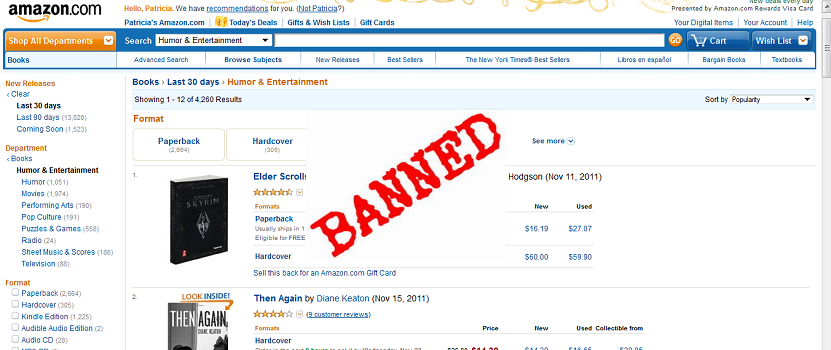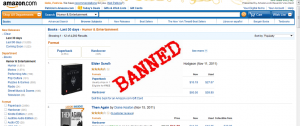
Avoid Getting Banned from Amazon as an Author! – Part 1
 Avoid Getting Banned from Amazon as an Author! – Part 1
Avoid Getting Banned from Amazon as an Author! – Part 1
So your book is now finished and up on Amazon shelves and you are keen to push the sales. Yet, better beware of using tactics that are in violation with the Terms and Condition of Amazon Kindle Direct Publishing, as this would effectively give Amazon grounds to ban you for life from using their services as an author. As 80% of online book sales typically come from Amazon, this would be equivalent to signing a death warrant to your career as a writer, at least as long as Amazon dominates the market.
So beware of the following:
- Playing with prices
- Holding multiple accounts
- Revealing confidential information
- Failing to abide to the conditions warranting payment of royalties
- Publishing “inappropriate” content
The first two items are quite clear cut and will be explored today. The third and fourth ones seem quite straightforward as well but the last one is much harder to define. Today, we will have a look at the first two, with the next two for tomorrow, leaving the thornier issues of what is appropriate for Monday. That should leave enough time to get mentally ready to face the terrifying findings on amazon KDP Terms and Conditions…
- Playing with prices
The Pricing Page referred to repeatedly in the Terms and Conditions states that:
4. Setting Your List Price
You must set your Digital Book’s List Price (and change it from time-to-time if necessary) so that it is no higher than the list price in any sales channel for any digital or physical edition of the Digital Book.
But if you choose the 70% Royalty Option, you must further set and adjust your List Price so that it is at least 20% below the list price in any sales channel for any physical edition of the Digital Book.
By “list price in any sales channel,” we mean the suggested or recommended retail price or, if you sell your book directly to end users, your own sales price, for an edition of the book available outside of our Program.
When you set your List Price for our EU websites, you have to factor in the additional 15% value-added taxes (the Luxembourg statutory rate) we will add for EU customers, so that your List Price complies with this section after adding these VAT taxes.
(Note on April 26, 2012: This clause has now been modified and appears in the new section 5.3.2:
To the extent permissible under applicable local laws, we have sole and complete discretion to set the retail price at which your Digital Books are sold through the Program.
This means that you provide a list price, but if Amazon need to sell cheaper “to match a third party’s sales price for any digital or physical edition of the Digital Book” they can do so. (Whether or not this affects your royalties depends on whether it was a 35% (it doesn’t) or 70% (it does) royalty book.)
When listening to the rumor that one might raise earning by setting the book price at $2.99 on Amazon to reach the 70% royalties rate defined in the Pricing Page ( see illustration) and then sell it at $0.99 in other outlets. Yes, Amazon will then have to sell the book to clients at $0.99, as per it’s obligation to match the lower price on the market and give you the 70% royalty rate as per your pricing requirement, but, as you would be in breach of your contract, this might result in being banned from Amazon. They do have a system in place to check if this is happening and will act upon it, so beware…
- Holding multiple accounts
For eBay shops, holding multiple accounts might be reputedly a very effective selling strategy, but this does not apply when talking about Amazon, and certainly not when talking about promoting your own book. Nevertheless, there are a lot of articles out there, written by website or blog owners specializing in driving traffic to eBay shops who are recklessly advising Amazon sellers, including authors, to open multiple accounts and use them to power up their sales figures.
Well, in one word, don’t! Amazon really frowns upon that and might suspend or ban you for it. Their Terms and Conditions are crystal clear about that.
4.2 Account Information; No Multiple Accounts. You must ensure that all information you provide in connection with establishing your Program account, such as your name, address and email, is accurate when you provided it, and you must keep it up to date as long as you use the Program. You may maintain only one account at a time. If we terminate your account, you will not establish a new account. You will not use false identities or impersonate any other person or use a username or password you are not authorized to use. You authorize us, directly or through third parties, to make any inquiries we consider appropriate to verify account information you provide. You also consent to us sending you emails relating to the Program from time to time. This takes precedence over any directions you may have given us, including through an Amazon web site.
So far, basically, these requirements of Amazon seem fair enough, summarized in two single sentences, “Don’t try to take advantage of our lower price on the market policy”, and “Don’t impersonate someone you are not”.
The other two restrictions we will cover tomorrow are slightly trickier.
Continue to part 2
Sign up for our RSS Feed, our Facebook page or our Twitter anchor to make sure you don’t miss it!